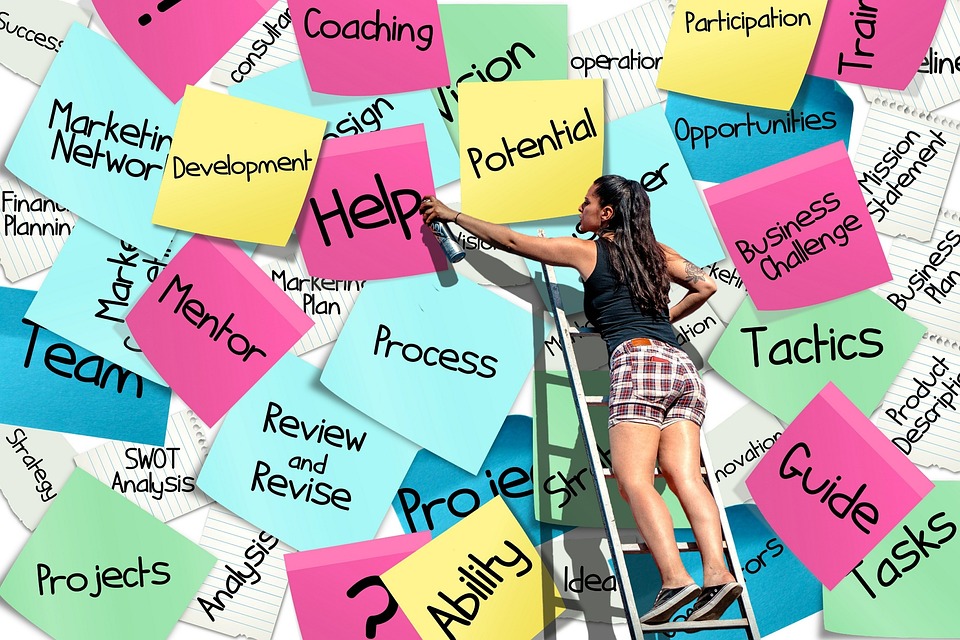Training and Development
From Success to Significance: How Coaching Can Help You Make a Lasting Impact

As you continue to climb the ladder of success, you may find yourself wondering what’s missing. You’ve achieved your goals, and yet, something feels unfulfilling. You’re not alone. Many high-achieving individuals experience a sense of emptiness, as if they’re just going through the motions. This is where coaching comes in – to help you transition from success to significance.
The Problem with Success
Success, by definition, is the attainment of a goal or the accomplishment of a task. It’s often associated with feelings of pride, satisfaction, and a sense of accomplishment. However, this success can be fleeting, leaving you wondering what’s next. The constant pursuit of success can be exhausting, leading to burnout and a loss of purpose.
What’s Missing?
So, what’s missing in the pursuit of success? It’s the sense of significance. Significance is about making a meaningful impact, leaving a lasting mark, and creating a legacy. It’s about going beyond just achieving success to making a difference in the world. Coaching can help you achieve this sense of significance.
The Role of Coaching
Coaching is a powerful tool that can help you transition from success to significance. A coach can help you:
-
Identify Your Values and Purpose
A coach can help you discover your core values and purpose, which is essential for making a lasting impact. By understanding what drives you, you can align your actions and decisions with your values, creating a sense of direction and purpose.
-
Clarify Your Vision
A coach can help you develop a clear vision for your life and work. This vision should be inspiring, challenging, and aligned with your values and purpose. With a clear vision, you’ll be able to focus your efforts and make decisions that support your goals.
-
Develop a Plan of Action
A coach can help you create a plan of action, breaking down your vision into smaller, achievable steps. This plan will serve as a roadmap for your journey, helping you stay focused and motivated.
-
Overcome Obstacles and Challenges
A coach can provide guidance and support as you navigate the challenges that inevitably arise. They can help you develop strategies for overcoming obstacles, building resilience, and staying committed to your goals.
Conclusion
Coaching can be a powerful tool in helping you transition from success to significance. By identifying your values and purpose, clarifying your vision, developing a plan of action, and overcoming obstacles, you can make a lasting impact and create a legacy. If you’re ready to take your life and work to the next level, consider working with a coach who can help you achieve your goals and make a difference in the world.
FAQs
What is Coaching?
Coaching is a collaborative process between a coach and a client, designed to help the client achieve their goals and enhance their performance. Coaches work with clients to identify and address challenges, develop strategies, and create a plan of action.
How Does Coaching Differ from Consulting?
Coaching differs from consulting in that it’s a more collaborative and less prescriptive process. Coaches don’t provide solutions or tell the client what to do; instead, they guide the client in discovering their own solutions. Coaching is focused on personal and professional growth, while consulting is focused on solving specific problems or improving performance.
How Long Does Coaching Typically Last?
Coaching can last anywhere from a few sessions to several months or even years. The length of a coaching engagement depends on the client’s goals, needs, and preferences. Some coaches may offer packages or programs with a specific number of sessions, while others may offer ongoing support and guidance.
Can Anyone Benefit from Coaching?
Yes, anyone can benefit from coaching. Whether you’re a high-achieving individual looking to make a greater impact or someone seeking to make a career change, coaching can help. Coaches work with clients from a wide range of backgrounds and industries, and the process is tailored to meet the unique needs and goals of each individual.
How Do I Find a Coach?
Finding a coach is easier than ever. You can search online for coaches in your area, ask for referrals from friends or colleagues, or explore professional associations like the International Coach Federation. When selecting a coach, consider their experience, qualifications, and approach to ensure you find the right fit for your needs.
Note: This is a sample article, please make sure to proofread it and make necessary changes according to your requirements.
Training and Development
Learning on the Job Is Back in Style

There was a time when most people believed skill-building happened in classrooms, workshops, or weekend certifications. But, a growing number of professionals and companies are rediscovering something powerful: the best development often happens right where you are—on the job.
With budgets tightening and tech evolving fast, organizations are rethinking how they train talent. Instead of relying solely on outside courses, many are shifting toward embedded learning—real-time, hands-on growth inside the workplace.
This doesn’t mean formal training is going away. It means companies are realizing that development doesn’t need to be separate from the work—it can be part of it.
The Rise of Experiential Learning
Experiential learning—also called on-the-job training or work-integrated development—isn’t a new concept. It’s how tradespeople, apprentices, and field workers have learned for generations. What’s different now is how companies are using it strategically across industries, levels, and departments.
Instead of pulling employees away from their roles to “learn,” leaders are asking:
-
What skills can we build while they’re doing the work?
-
How can we give people stretch projects instead of just tasks?
-
Can we create learning loops in our everyday workflows?
This shift reflects a key truth: people retain more when they learn by doing. According to the Association for Talent Development (ATD), learners retain up to 75% of information when they apply it immediately on the job, compared to just 10% when learning passively in a lecture.
Microlearning, Mentorship, and Manager Coaching
In today’s fast-paced work environments, few people have time for day-long training sessions. That’s why microlearning—bite-sized, actionable lessons delivered in 10–15 minute formats—is taking off. Teams are now integrating these into their weekly meetings, Slack channels, or digital platforms to make learning quick, accessible, and consistent.
Equally important is mentorship and manager-led coaching. Gone are the days when professional development was only HR’s responsibility. Now, direct managers are being trained to:
-
Offer real-time feedback
-
Guide learning goals tied to actual projects
-
Create a culture of curiosity, not perfectionism
A 2025 LinkedIn Workplace Learning report revealed that employees who receive weekly coaching and stretch assignments from their manager are 3x more likely to report satisfaction with their career growth.
Training Tailored to the Individual
Not everyone learns the same way—or wants the same path. Leading organizations are investing in personalized development plans based on individual career goals, skill gaps, and learning preferences.
Whether someone wants to upskill in data tools, lead more effectively, or explore a new department, customized plans help them feel seen and supported. And that matters—especially when retention is on the line.
It’s also why companies are introducing internal mobility programs. Instead of losing high-potential employees to outside job offers, they’re creating structured ways for them to reskill and pivot into new roles inside the organization.
Why Employees Are Driving the Shift
There’s a new expectation from today’s workforce: If I’m going to stay, I need to grow.
Employees—especially Gen Z and younger Millennials—aren’t waiting for yearly performance reviews. They’re asking:
-
“What am I learning here?”
-
“How does this job prepare me for the next one?”
-
“Am I gaining skills that are transferable?”
In response, smart organizations are treating training and development as a core part of employee experience—not just a checkbox.
And it’s not just about career advancement. Learning boosts confidence, combats burnout, and keeps employees engaged even when business gets tough.
The Role of Technology
AI and tech tools are making workplace learning smarter than ever. Platforms like Workday, Coursera for Business, and LinkedIn Learning are using data to:
-
Recommend personalized courses
-
Track skill development across departments
-
Identify emerging skills needed by the company
These tools help bridge the gap between individual growth and organizational strategy—making training measurable, scalable, and relevant in real-time.
Let’s Rethink What Training Looks Like
Workplace learning doesn’t need to be expensive or complicated. It needs to be intentional.
Start small:
-
Let someone shadow a senior team member for a day
-
Break a complex task into a learning opportunity
-
Ask during 1:1s, “What do you want to get better at?”
These moments matter more than we realize.
The Wrap-Up: Growth Happens in Motion
You don’t have to pause progress to build skills. And you don’t need to be in a classroom to become a better professional.
Growth happens in motion—while solving a problem, asking a new question, or saying yes to something slightly out of your comfort zone.
So the next time someone asks what your training strategy is, don’t just point to a course catalog. Point to the culture, the conversations, the everyday chances to stretch.
Because real development isn’t an event. It’s a way of working.
Training and Development
Teach Your Team to Think, Not Just Do

Training programs are everywhere—but that doesn’t mean they’re effective.
It’s one thing to teach employees what to do. It’s another to teach them how to think. And the organizations that invest in developing critical thinking—not just compliance—are building stronger, more resilient teams.
So how do you go beyond task training? It starts with shifting from checklists to curiosity.
Why Execution Isn’t Enough
Many workplaces train for performance. That means:
-
Learning how to follow procedures
-
Knowing which button to click
-
Memorizing steps to complete a task
That kind of training is helpful—for consistency, safety, and speed. But it has limits. When something breaks, when the unexpected happens, or when new challenges show up, step-by-step thinking stalls.
That’s where problem-solvers rise.
Critical thinkers don’t just follow directions. They ask better questions, anticipate risks, identify root causes, and explore alternatives. They don’t wait to be told what to do next—they’re already thinking two steps ahead.
That mindset is a skill. And it can be taught.
Start With Better Questions
Most workplace training is focused on answers. What if it started with better questions instead?
Try shifting your training conversations like this:
-
From “Here’s how to do it” → to “What do you notice about this?”
-
From “Follow these steps” → to “How would you approach this if something went wrong?”
-
From “That’s incorrect” → to “What made you choose that option?”
Encouraging questions over instructions builds ownership. It also invites employees to reflect, problem-solve, and use judgment—skills that matter more than ever when workflows change and ambiguity is part of the job.
Build Thinking Time Into Learning
So many employees are caught in “do more” mode that they don’t get space to actually think about how they’re working. That’s a training failure—not a performance one.
Here’s one fix: slow down long enough to debrief.
After a project wraps, host a 10-minute reflection session. Ask:
-
What worked and why?
-
Where did we hit friction?
-
What would we change next time?
Or better yet—have team members lead their own debriefs. That kind of micro-reflection builds leadership skills while reinforcing learning in real time.
Make Problem Solving Part of Every Role
Thinking isn’t reserved for managers or strategists. Everyone—from admin staff to tech support—benefits from problem-solving skills. But if you want that kind of thinking, you have to make space for it.
Here are a few ways to do that:
-
Create “what if” drills for teams to practice responding to issues
-
Include decision-making scenarios in onboarding
-
Encourage peer brainstorming when problems arise, not just solo troubleshooting
-
Reward creative solutions—not just fast fixes
The goal isn’t to make every employee an expert. It’s to help them feel more capable, trusted, and equipped to act with confidence when there’s no script to follow.
Stop Relying on Experts for Every Answer
One of the biggest blockers to team development? When all decisions bottleneck at the top.
If you want to grow your people, let them try. Let them lead something small. Let them fail forward. Give them the training, then step back.
This doesn’t mean abandoning oversight. It means practicing guided ownership—a balance of support and autonomy that turns employees into independent thinkers instead of task-takers.
It’s not always fast. But it’s how you build a bench of leaders ready for whatever comes next.
The Real Value Isn’t in the Training Itself
It’s easy to measure training by hours logged, certificates earned, or modules completed. But that doesn’t reflect what matters most.
The real value of training is this: Did it change the way someone thinks? Does your team feel more capable, more curious, and more confident after learning?
If the answer is yes, then you’re not just training workers. You’re developing thinkers.
And thinkers are the ones who solve problems, lead change, and keep your organization learning long after the training ends.
Training and Development
What if the real problem isn’t the talent—It’s the training?

Hiring teams are scrambling. Open roles stay vacant for months. New hires burn out fast. And middle managers keep asking the same question: “Where are all the qualified people?”
But maybe the better question is this: Are we setting them up to succeed once they get here?
In 2025, the training gap is no longer about access. It’s about alignment. Most companies offer plenty of resources—onboarding checklists, knowledge bases, online portals. But if talent keeps churning or underperforming, the issue might not be skill. It might be how organizations are (or aren’t) developing people.
The Hidden Cost of Weak Onboarding
You can’t build confidence on confusion. Yet many new employees are dropped into fast-paced roles with minimal structure, little context, and no long-term development path. This leads to:
-
Lower retention within the first 90 days
-
More errors or missed expectations
-
A lack of engagement from the start
The cost of poor onboarding goes beyond logistics—it shapes first impressions, which shape culture.
The Shift Toward Enablement, Not Just Orientation
Forward-thinking companies are ditching the “day one overload” and moving toward staggered, strategic onboarding. That means:
-
Starting with what matters most in the first two weeks
-
Pairing employees with peer coaches or learning partners
-
Creating interactive training experiences, not static PDFs
-
Offering real-time feedback and low-risk practice opportunities
This is how you create workers who feel capable, not just informed.
Why Development Needs to Be a System, Not an Event
The most successful companies treat training like a product—it evolves, it’s tested, and it’s built around the user. That means:
-
Listening to feedback from learners at every level
-
Adjusting delivery based on how people actually work
-
Tracking behavior change, not just course completions
When learning is embedded in the system, development becomes part of the culture—not something you scramble to fix when someone starts underperforming.
Snapshot Story:
At a mid-sized tech firm in Atlanta, leadership noticed that sales reps were consistently underperforming in their first three months. Instead of assuming the problem was hiring, they restructured onboarding to focus on role-shadowing, targeted product demos, and weekly check-ins for skill reinforcement.
Twelve months later, first-quarter retention improved by 27%, and new reps ramped up to quota twice as fast.
The talent was always there. The training just needed to catch up.
-

 Career Advice6 months ago
Career Advice6 months agoInterview with Dr. Kristy K. Taylor, WORxK Global News Magazine Founder
-

 Diversity and Inclusion (DEIA)6 months ago
Diversity and Inclusion (DEIA)6 months agoSarah Herrlinger Talks AirPods Pro Hearing Aid
-

 Career Advice6 months ago
Career Advice6 months agoNetWork Your Way to Success: Top Tips for Maximizing Your Professional Network
-

 Changemaker Interviews5 months ago
Changemaker Interviews5 months agoUnlocking Human Potential: Kim Groshek’s Journey to Transforming Leadership and Stress Resilience
-

 Diversity and Inclusion (DEIA)6 months ago
Diversity and Inclusion (DEIA)6 months agoThe Power of Belonging: Why Feeling Accepted Matters in the Workplace
-

 Global Trends and Politics6 months ago
Global Trends and Politics6 months agoHealth-care stocks fall after Warren PBM bill, Brian Thompson shooting
-

 Global Trends and Politics6 months ago
Global Trends and Politics6 months agoUnionization Goes Mainstream: How the Changing Workforce is Driving Demand for Collective Bargaining
-

 Training and Development6 months ago
Training and Development6 months agoLevel Up: How Upskilling Can Help You Stay Ahead of the Curve in a Rapidly Changing Industry









